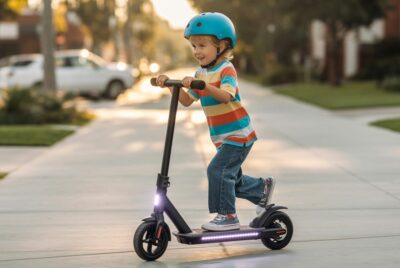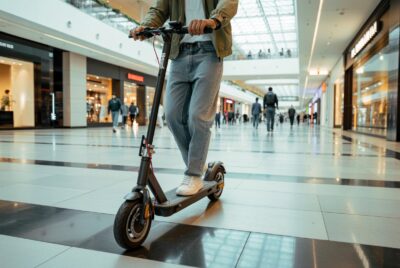The Pros and Cons of Owning an Electric Scooter
*We may earn a commission for purchases made using our links. Please see our disclosure to learn more.
Key Takeaways
The Pros of Electric Scooter Ownership
1. Cost-Effective Transportation
2. Environmental Benefits
3. Time Savings and Convenience
4. Accessibility and Ease of Use
5. Joy Factor
The Cons of Electric Scooter Ownership
1. Weather Limitations
Perhaps the most significant drawback I’ve experienced is the weather dependency. When it rains, snows, or gets icy, my scooter stays home. Most consumer electric scooters have limited water resistance, making them unsafe or potentially damaging to use in wet conditions. Even those advertised as “water-resistant” are typically only protected against light splashes, not downpours.
During winter months, I’ve had to revert to public transportation for almost six weeks straight due to unsafe riding conditions. If you live in a climate with significant seasonal weather variations, you’ll need a backup transportation plan for inclement weather days. This is one of the key pros and cons of owning an electric scooter that potential buyers should consider.
2. Battery Range Anxiety
While electric scooter technology has improved significantly, battery limitations remain a concern. My scooter advertised a 25-mile range, but in real-world conditions (hills, stop-and-go riding, cold weather), I typically get about 18 miles before needing to recharge.
This creates what I call “range anxiety”, that constant mental calculation of whether you have enough battery to complete your journey. For predictable commuting, this becomes less of an issue as you learn your scooter’s true capabilities, but it can limit spontaneous trips or longer journeys. And if you forget to charge overnight, you might find yourself unexpectedly using alternative transportation in the morning.
3. Safety Concerns
I can’t discuss electric scooters honestly without addressing safety issues. With speeds typically ranging from 15-30 mph, accidents can lead to serious injuries. In my first year of scooter ownership, I had two minor falls – nothing serious, but enough to reinforce the importance of wearing proper safety gear.
Statistics show that head injuries are the most common serious injury for scooter riders. After researching accident data, I now always wear a helmet and wrist guards, but many riders don’t take these precautions. Additionally, sharing the road with much larger vehicles adds an element of vulnerability that can be uncomfortable for some riders.
4. Regulatory Uncertainty
When I purchased my scooter, I was surprised to learn how varied and sometimes unclear the regulations are regarding where and how electric scooters can legally operate. In some cities, they’re permitted on roads but not sidewalks; in others, the opposite is true. Some areas require helmets, others don’t, and speed limits vary widely.
This regulatory patchwork continues to evolve, meaning what’s legal today might not be tomorrow. I’ve had to adjust my routes several times due to rule changes, and I’ve heard stories of riders facing unexpected fines. Before purchasing, it’s crucial to research the specific regulations in your area and stay informed about potential changes.
5. Theft Risk and Storage Challenges
Electric scooters are attractive targets for thieves due to their portability and resale value. Even with a good lock, they’re easier to steal than bicycles or motorcycles. I’ve had to adjust my lifestyle to accommodate always bringing my scooter inside rather than locking it outside, which isn’t always convenient.
Storage at home can also present challenges, especially in small apartments. My scooter folds, but it still takes up significant space in my entryway. For those in walk-up apartments, carrying a 30+ pound scooter up multiple flights of stairs can quickly become tiresome.
6. Limited Cargo Capacity
One practical limitation I face daily is the minimal cargo capacity of electric scooters. Grocery shopping, for instance, requires careful planning as I can only carry what fits in my backpack. Larger purchases or transporting bulky items means finding alternative transportation.
Some scooters offer attachable storage options, but they’re generally limited compared to bicycles with baskets or panniers, and certainly far less than cars. For singles or couples with minimal hauling needs, this might be manageable, but for families or those who regularly transport larger items, it’s a significant limitation.
Who Should Consider an Electric Scooter?
Based on my experience, electric scooters are best suited for:
- Urban dwellers with commutes under 10 miles each way
- People who have access to secure indoor storage at both home and work
- Those living in areas with moderate climate and good road infrastructure
- Individuals looking to reduce transportation costs and environmental impact
- People comfortable with the safety aspects of standing transportation
Electric scooters may not be ideal for:
- Those living in areas with frequent inclement weather
- People who need to transport children, pets, or large items regularly
- Individuals with certain mobility or balance issues
- Those living in areas with prohibitive regulations or lack of infrastructure
Financial Considerations
Beyond the initial purchase price, prospective electric scooter owners should consider the pros and cons of owning an electric scooter before making a decision.
Initial Cost Range:
- Budget models: $300-$500 (limited range and features)
- Mid-range models: $600-$1,000 (better range, suspension, durability)
- Premium models: $1,000-$1,500+ (extended range, superior build quality)
Ongoing Expenses:
- Electricity for charging: Minimal, typically $1-2 monthly
- Maintenance: $50-150 annually depending on use intensity
- Safety gear: $50-200 for helmet, pads, visibility items
- Potential accessories: Locks, lights, phone mounts ($50-150)
- Insurance: Optional but increasingly available ($100-300 annually)
The Learning Curve
While I mentioned that electric scooters are relatively easy to learn, there is still a learning curve that deserves attention. My first few days of ownership involved some wobbly moments and uncertainty about navigating different terrain types.
Most riders achieve basic proficiency within an hour, but developing the confidence to navigate busy streets, uneven pavement, and various obstacles takes longer. Within a week, I was comfortable with my daily route, but it took about a month before I felt truly confident in all urban riding situations. Understanding the pros and cons of owning an electric scooter means acknowledging this initial learning curve and the time it takes to ride safely and efficiently.
The learning process involves:
- Mastering balance while accelerating and braking
- Developing awareness of your surroundings at higher speeds
- Learning to anticipate potential hazards like potholes or car doors
- Understanding how your particular scooter handles different conditions
For those completely new to personal electric vehicles, I’d recommend practicing in empty parking lots or quiet streets before venturing into busy areas. The investment in this practice time pays significant dividends in safety and confidence.
Community and Culture
An unexpected benefit of electric scooter ownership has been connecting with a growing community of riders. In many cities, scooter enthusiasts organize group rides, share maintenance tips online, and advocate for better infrastructure. This social aspect has enriched my experience beyond mere transportation.
I’ve found fellow scooter owners to be generally helpful and eager to share advice about routes, maintenance, and accessories. Several times I’ve been approached by curious pedestrians asking about my experience, suggesting that electric scooters still maintain a certain novelty factor that sparks conversations.
This community aspect may not be important to everyone, but for those who enjoy the social dimensions of their transportation choices, it’s worth noting that electric scooters can provide more than just a means of getting from point A to point B.
Conclusion
After two years of electric scooter ownership, I can confidently say it has transformed my urban transportation experience for the better. The financial savings, environmental benefits, time efficiency, and simple joy of riding have made it one of my better purchase decisions. That said, the weather limitations, safety concerns, and practical constraints are real factors that potential buyers should weigh carefully.
Electric scooters represent a middle ground in the transportation spectrum, more efficient than walking, more convenient than bicycles for many users, more affordable than cars, yet more weather-dependent and limited in range than public transit. They’re not a universal solution but rather a valuable option in a diverse transportation ecosystem.
If you’re considering an electric scooter, I’d recommend starting with a thorough assessment of your specific needs, local regulations, climate conditions, and storage options. Test ride different models if possible, and perhaps even rent one for a week to experience the reality of scooter commuting before making the investment.
For the right person in the right circumstances, an electric scooter can be not just a practical transportation choice but a lifestyle upgrade that brings unexpected benefits to daily life. Despite the drawbacks I’ve experienced, I remain a committed and enthusiastic electric scooter owner with no plans to return to my pre-scooter transportation methods.
Frequently Asked Questions
How long do electric scooters typically last?
With proper maintenance, a quality electric scooter can last 3-5 years of regular use. The battery is usually the first component to degrade, typically maintaining about 80% of its original capacity after 500-1000 charge cycles. Other components like tires, brakes, and folding mechanisms will need occasional replacement or maintenance. I’m in year two with my current scooter, and while I’ve replaced the tires once and tightened various components, it’s still performing well.
Are electric scooters legal everywhere?
No, regulations vary significantly between countries, states, and even cities. Some areas permit electric scooters on roads but not sidewalks, others allow them on sidewalks but not roads, and some have specific bike lane requirements. Maximum speed limits, helmet requirements, and age restrictions also vary widely. Before purchasing, check your local transportation department’s website for current regulations, as these rules continue to evolve as electric scooters become more common.
How far can an electric scooter go on a single charge?
Most consumer electric scooters advertise ranges between 15-40 miles per charge, but real-world range is typically 20-30% less than advertised. Factors that reduce range include rider weight, terrain (hills reduce range significantly), riding style (frequent stops and starts), and temperature (cold weather diminishes battery performance). My scooter advertises 25 miles, but I typically get 18-20 miles in normal conditions and as little as 14 miles in cold weather or hilly routes.
Are electric scooters difficult to maintain?
Basic maintenance is relatively simple and can be done at home with minimal tools. This includes tire pressure checks, brake adjustments, and keeping components clean and tight. More complex issues like motor or controller problems typically require professional service. I spend about 30 minutes monthly on basic maintenance and have needed professional help only once in two years. Most manufacturers provide guidance on routine maintenance in the owner’s manual, and online tutorials are plentiful for common models.
How much does it cost to charge an electric scooter?
Charging costs are minimal – one of the major advantages of electric scooters. A typical electric scooter battery has a capacity of 250-600 watt-hours. At the average U.S. electricity rate of about $0.14 per kilowatt-hour, a full charge costs between $0.04 and $0.08. Even with daily charging, this amounts to only $1.20-$2.40 per month. My own monthly charging cost is approximately $1.50, making the operating cost dramatically lower than any other motorized transportation option.




